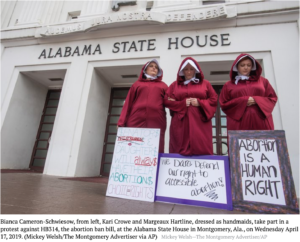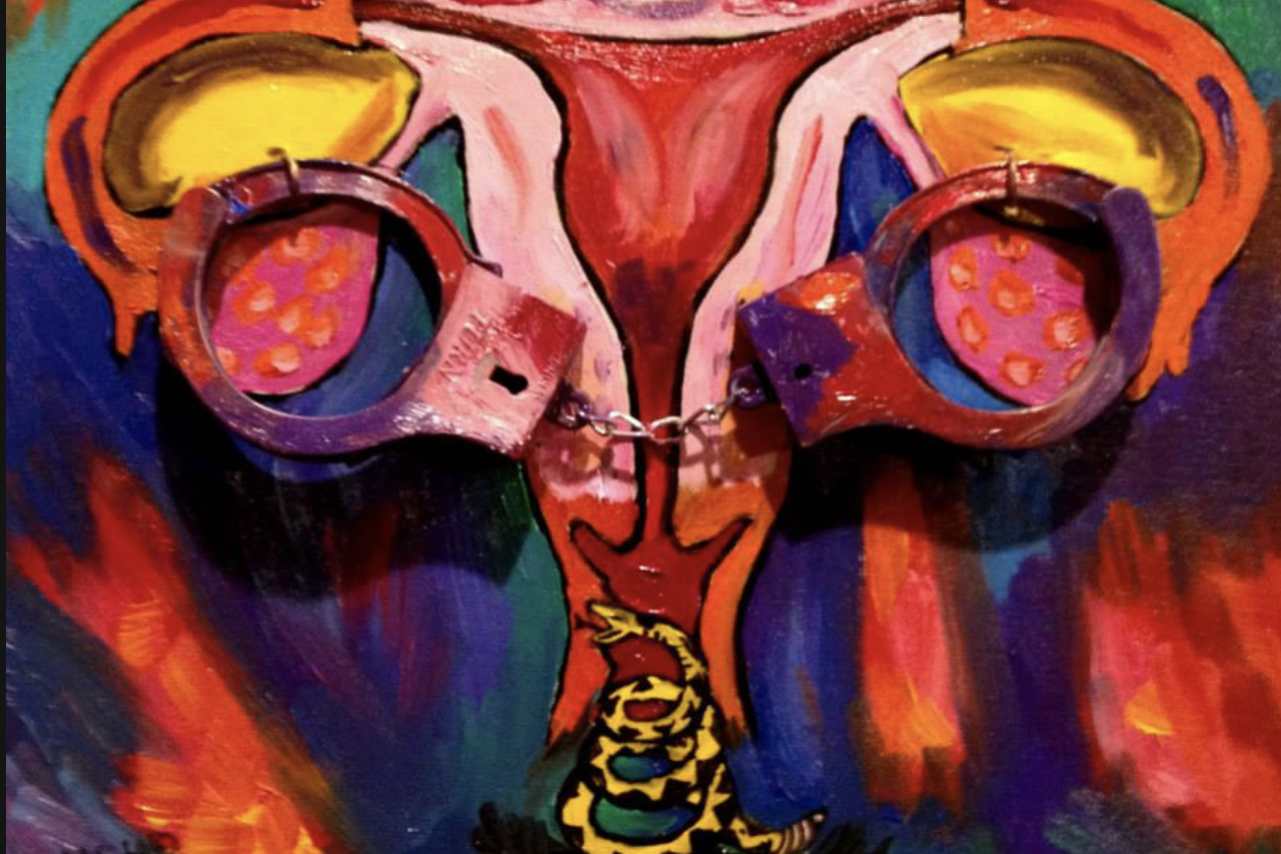Translated by Janet Haney
From: www.thelacanianreviews.com
Have you seen and listened to Kay Ivey? A powerful old lady! She is the current governor of Alabama and has just promulgated the Alabama Human Life Protection Act. Protecting human life seems a respectable position, even if it is incoherent not to see beyond her own species, and not to protect the planet on which these human beings may or may not survive. Thus 25 white Republican men decided to outlaw abortion in Alabama, without exception, even in cases of rape or incest. The reproduction of life has been given preference over one of the fundamentals of the symbolic, the law prohibiting incest, the base itself not only of the human family and therefore any human group, but also of all interaction between speaking beings. The reproduction of life has also been chosen over human rights as rape is a crime that reduces a speaking being to an object against her will and her desire. Life versus women, verses The law of the family, life verses the speaking being. I have good reason to be touched by this. Throughout my childhood I heard my grandmother speaking about her friends who had died following illegal abortions before and after the Second World War.
Only rarely is abortion a symptom in itself. It happens, but not very often. Most of the time it is the result of a conflict between the law of desire and human laws, or the semblants that govern any given society. It is the manifestation in a speaking being of the division or of the split between a woman and a mother. In short, it is generally about a forced choice that leaves a mark and is traumatic in the sense that Lacan gives to the term. Because when the speaking beings are females, there is a particular characteristic: Life, which I write with a capital letter to differentiate it from the little lives that are our little stories, our tiny lives – the force of Life is of the order of the real. Not very accessible to the power of the symbolic, touched only by the mathematical writing of the sciences, Life at times traverses the body of female speaking beings in the form of their specific function in reproduction, namely pregnancy and childbirth. During a birth, Life, blind and dumb, takes possession of the body of a speaking being and reproduces itself through her, regardless of whether the individual survives or not. This holds good for all living species. Abortion demonstrates a human objection to this power, an objection linked to the counter forces constituted by the symbolic and the imaginary. Abortion is human – profoundly human. It leaves traces on the subjects, ranging from relief to regret, and even to despair.
The current anti-abortion movement is global. It is driven by the new ascent of dictatorial and authoritarian powers around the world which use the discourse of religion, essentially monotheistic, in order to impose itself. As was recently said by Angelina Harari, President of the World Association of Psychoanalysis, with regard to the last election in Brazil, the coming out of reactionary man is happening all over the world.
These religions, like all established institutions, are systems that model the social bond and regulate the relationship of an individual to his or her body. They use the love of God to manage the masses, in the name of the father or brother – it is associated with the male. To get to the point, religious discourses police the body. They say which modalities of jouissance are authorised for a being speaking in a given group at a given time. Controlling little lives is useful for controlling life with a capital L. But this always comes about in the same way: by the imperative of reducing women to mothers. Abortion and contraception have been forbidden for centuries. This prohibition – which obviously doesn’t hinder the practice – was a major cause of female mortality, adding itself to the risks inherent in the specificity of the role of the female organism in reproduction.
In the twentieth century, the decline of patriarchy in conjunction with an extension of scientific knowledge and the domination of the capitalist discourse, had produced a noticeable amelioration of the situation. The support taken from the sciences today allows a management of reproduction that passes through individuals, the ones-all-alone, and increasingly escapes the traditional family order. This concerns sterility as well as fertility, and since the female organism is still irreplaceable today, we have witnessed a proliferation of alternative solutions to patriarchy: single-parent families, single mothers, surrogate mothers, homosexual families, etc.
But the essential point of today’s change of discourse is undoubtedly the fact that maternity no longer completely covers the feminine; maternity no longer exhausts it. Certainly the slogan of the medical hygienists of the nineteenth century – “The woman was born to be a mother” – had never convinced anyone and, besides, there have always been female destinies outside motherhood such as old maid, witch, saint, or whore. But a separation has become not only visible, but subjectively felt, between the mother-being and the woman-being. This has consequences.
Motherhood has ceased to be both an obligation of nature and a destiny of discourse, it has become a choice of jouissance, for which certain subjects, gendered as men, can opt. The difference between gender and the choice of jouissance has therefore become apparent. Let us posit, moreover, that the notion of gender has nothing to do but speak, and has no substance other than that of semblant, which, obviously, is not nothing. The downgrading or even the segregation of discourse and speech of the woman in the mother no longer fully operates.
There is therefore a reversal of scheduling. If, in the traditional discourse, there was first the mother and then, second, the woman, today there are first of all women who can make a choice about maternity. This is duplicated by the fact that the same possibility of choice is also claimed for the choice of gender.
So how can we account for recent victories over and current threats towards abortion and contraception, at a time when the number of human beings on the planet has never been greater or more worrying? How can we explain the fact that there are many women who support this orientation, from Kay Ivey to the young women converts who join the ranks of the jihadists and take up the role of laying eggs for the cause?
If we take into account the fact that the large-scale movement now developing under the impulse of the globalized economy is a movement towards universality that opposes the real (understood here as sexual) as a modality, and that the struggles for man/woman equality lead to thinking of women as no different from men – same rights, same functions, same desires – would motherhood become segregation’s stronghold? Would it do so on the model of the claims – so-called minority claims – which also defend the difference segregatively? It would be maternity used as a machine in the war against a universalist and masculine feminism.
Faced with a push to LOM, as speaking-being, faced with this “universalizing masculinization”, would this reactionary movement concerning the rights of women, would it maintain that, when the father fades and the family mutates, the moment has come for the mother to take up the baton, that is to say, to take power? Lacan anticipated this in the seminar Les non-dupes errent.[1]

From Time.com: full text in: https://time.com/5590420/alabama-abortion-law-roe/
When Truth Has Structure of Fiction
Let’s take a detour via a world-famous TV series, The Handmaid’s Tale, an adaptation of Margaret Atwood’s bestselling speculative story.
There are women who are sterile and women who are fertile. In this story, an interpretation of the reactionary turn taken by modernity, the order of this religious state puts this “fact” (an extension of female sterility representing a threat to the species) at the service of its master-slave principle of social organization. Women are excluded, be they masters or slaves, from all public speech and from all transmission of knowledge. This return to the past puts the technical resources of modernity at the service of the masters and allies itself with ecological concerns. Wives must dedicate themselves only to their husbands and masters, to children and the home. The traditional difference between men and women seems to be in full swing. Those that can reproduce the species are put at the service of the master couples. They are reduced to the reproduction function and excluded from motherhood which is the province of the wives of the masters. The mother-being is thus linked to the wife-being and separated from the question of fertility. There are therefore the mother-wives and the fertile handmaids, in other words the surrogates. The system, however, has been conceived and realized by those who dominate, by women as much as by men. They have therefore worked to put in place a system which positions, as one of its cornerstones, the manufacture by culture of a man-woman difference which is attributed to nature, materialized by “having or raising a child”. They are all Kay Ivey and evoke those women who are now voting to confine women to the home of which they are the guarantors. The cause of the powerful mothers is opposed to that of the reproducers, who are deprived of all human rights, deprived of their children, that is, deprived of their object a and reduced to sexual slavery. Obviously the feminine is back: sexual desire and love for the reproductive handmaids. As regards to the mistresses, the arrival of the coveted object child provokes an upheaval that soon brings back the cause of women and the quest for abandoned political power.
If the heroine chooses to be the mother of a child, it is for a man that she desires. She refuses to be a surrogate, raped every month in an act described as a “ceremony”. She is thus not all mother, but also a desiring woman, a lover, and a politician. As for the mistress, the desire for a child and the child’s arrival leads her to take up the public podium, to want for her daughter a destiny as a woman other than the one she had chosen for herself, at the cost of parting.
Putting the mother in the place of the father (when the family fails and turns out to be nothing other than a herd of slaves[2]led by dictators) is paid for by the sacrifice of the feminine. This TV series shows that in order to be sacrificed to the maternal, the feminine persists as a real that it is impossible to saturate. The feminine, not without Feminism certainly, but different, supplementary, seizes all the contingencies that offer themselves. It lodges, or even takes refuge, in the practice of silence, concealment, resistance, clandestinity, calculation, strategy, impulse, risk, even murder or death. The feminine is not the push to LOM, masculinization by gender, but a hidden part that always surprises the speaking bodies, like a wandering of the real, a gravitational wave resulting from the impossible fusion of Life and language.
[1] Lacan, J., Seminar XXI, Les non-dupes errent, lesson of 19 March 1974 (unpublished).
[2] Lacan, J., Seminar XIX, … or Worse, Cambridge, Polity, 2018, p. 185.








